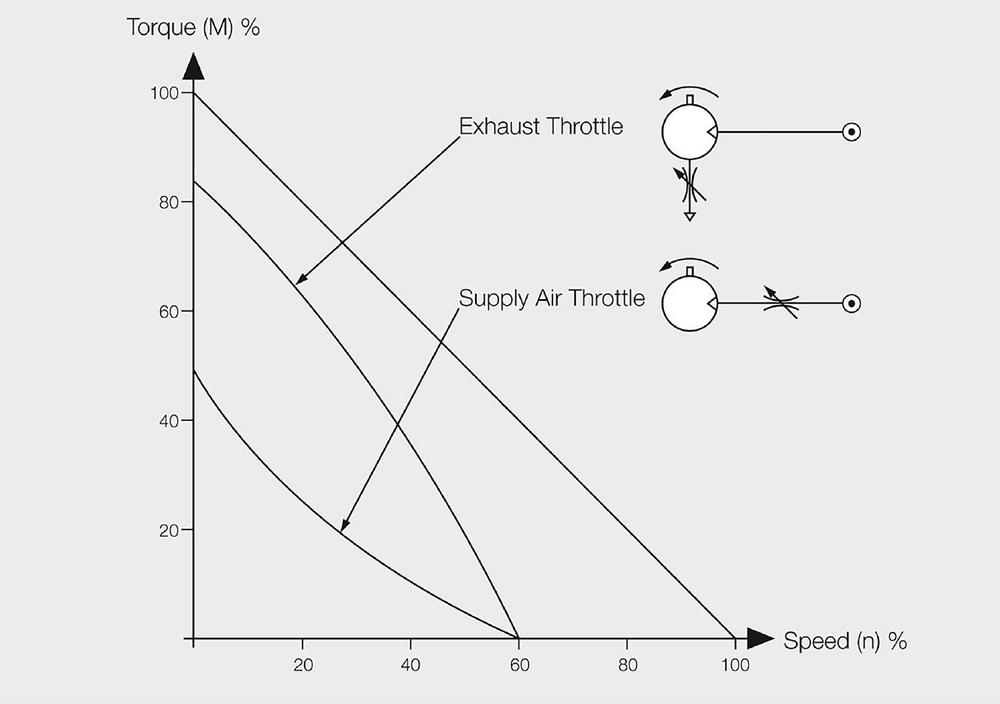Paper webs, for example, are rolled with a diameter of around two metres at high speeds of up to 2,000 m/min. Films are sensitive materials which must be wound or unwound extremely precisely, and the winding of metals adds the issue of heavy masses which influence the winding process. One range of drives which embody the required versatility is found in the air motors from DEPRAG SCHULZ GMBH u. CO.
The vane motor works according to a simple principle. The rotor turning in an eccentric cylinder is set into motion. Centrifugal force presses the vanes against the rotor wall and working chambers are built. In these working chambers the compressed air expands, pressure energy is converted into kinetic energy and the rotor turns.
Typical to pneumatic motors is the automatic adjustment of speed when there is a load variation. At idle speed, the air motor works with a complete removal of load. If there is a low load, meaning a low torque on the motor spindle, the working speed is close to the idle speed. The working speed lessens as soon as the torque increases. At 50 % of the idle speed, the air motor reaches maximum power. In this range it is particularly energy efficient.
In comparison with electric motors, the air motors have a high starting torque and can be loaded or even overloaded to standstill with no problems. After a reduction of load, the air motor continues running as normal. An additional advantage is the lessening energy requirements of air motors as the torque increases. In comparison, the electric motor uses the most electricity at maximum torque. Furthermore, compressed air is, in principle an unproblematic energy source: There are no electrical hazards and short circuiting is impossible.
Design to maximum torque
Above all, the required winding speed and the maximum torque are decisive for motor design. For the calculation of the maximum torque, the largest possible reel diameter is taken i.e. the reel in its fully wound state. The winding speed should also be determined at the fully wound state. However, when the reel is carrying less material, the reel diameter is smaller, and the motor automatically winds the material faster – the working speed adjusts to correspond with the load (the lower torque). If the motor is turning too quickly, the speed can be smoothly adjusted by altering the air volume, the operating pressure or a combination of the two.
Speed regulation using air volume
Through regulation of the air volume, speed can easily and flexibly by reduced. Depending on the application either supply or exhaust throttling can be used. Exhaust air throttling reduces the speed of the motor without a noticeable loss of power or reduction of the air motor’s torque. Exhaust air is kept back by a throttle valve, creating a backlog or counter-pressure and the speed is reduced.
If you also wish to reduce the power or torque of the motor, then supply air throttling would be recommended. If, for example, the winding application requires that continuous material be kept taut, then the motor must also continuously receive air.
Speed regulation using operating pressure
The technical data of DEPRAG air drives is based on an operating pressure of 6 bar. Every one of these motors can be operated between 4 and 6.3 bar as required in order to adjust the power needed for the corresponding application. If, for example, an air motor is too “strong” for the paper to be wound, the paper could tear during winding. In this case, a reduction of the operating pressure would be recommended. In combination with supply air throttling, the motor power can be reduced so that tearing is prevented. A reduction of the operating pressure by 1 bar effects a reduction of the torque by 17 %. If the motor is operated at 4 bar, the torque is reduced by 33 %.
In a winding application, an air motor which is operated at 4 bar can still be too strong for a reel which is emptying. In order to further take advantage of the torque range of the air motor, DEPRAG can equip the motor with spring-loaded vanes, so-called forced start vanes. Using these vanes with leg springs, it is even possible to operate the air motor with an operating pressure of less than 1 bar.
ATEX and food safety
The air motors of the BASIC LINE, ADVANCED LINE and POWER LINE series are ATEX conform and authorised for use in potentially explosive areas. Through the expansion of air, any frictional warmth generated is cooled and even under load there is no possibility of overheating the vane motor or igniting gases. The internal overpressure also prevents the penetration of dirt and dust.
Air motors need to withstand cleaning agents and steam for use in food preparation areas, e.g. for packaging machines. ADVANCED LINE motors have external parts made from stainless steel, are sealed and do not require additional housing. DEPRAG air motors can be run without lubrication, i.e. operated with unlubricated air. DEPRAG uses a food legislation compliant lubrication USDA-H1 grease for the planetary gears.
DEPRAG SCHULZ GMBH u. CO. based in Amberg, Germany has approx. 700 employees in over 50 countries around the world. DEPRAG is one of the market leading manufacturers of air motors with a wide spectrum of high quality, stainless steel drives and innovative turbines. The owner-run family business provides a standard program of diverse air motors from which individual drive solutions can be developed and produced using the modular principle at an attractive price-performance ratio.
DEPRAG SCHULZ GMBH u. CO.
Carl-Schulz-Platz 1
92224 Amberg
Telefon: +49 (9621) 371-0
Telefax: +49 (9621) 371-120
http://www.deprag.com
Pressekontakt
Telefon: +49 (9621) 371-343
Fax: +49 (9621) 371-199
E-Mail: d.duebbelde@deprag.de
